No products in the cart.
Table of Contents
Are you looking for a lovely variegated plant with perforated leaves? Monstera Adansonii Swiss Cheese is the best plant for you. Monstera Adansonii is well-known for its variegated foliage and leaves with holes, which require more light than those without variegation.
If you aspire to take care of this kind of plant, read more below to gain knowledge about this beautiful plant.
Variegated Monstera Adansonii Introduction
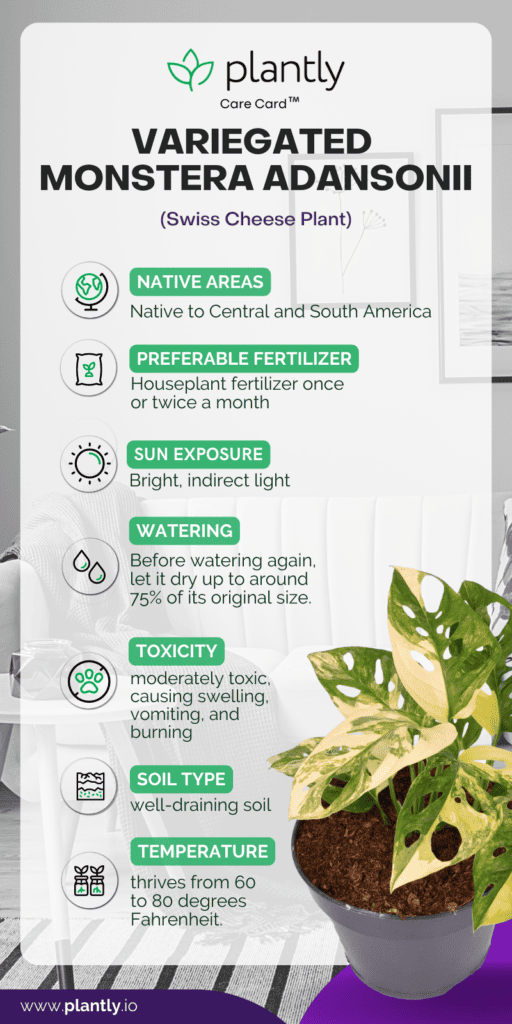
With the support of their aerial roots, these evergreen Hemi-epiphytes outdoor plants scale up to the trees. They, on the other hand, expand on the ground when they are young.
The majority of popular houseplants have a low-maintenance and beautiful appearance. Taking care of this plant differs from taking care of other plants. It is, nevertheless, simple to remain joyful and healthy.
You’ll be able to take care of this plant in a moment.
Variegated Monstera Adansonii Plant Care Basics

The Swiss cheese plant originates its name from its huge, heart-shaped leaves that develop holes (called “fenestration”) as the plant produces, giving it the appearance of Swiss cheese.
It’s known for being easy to manage and for climbing, providing it with a pole, moss stick, or trellis to cling to. This can result in some stunning displays, and it will produce larger leaves. Let’s dive deeper into its care basics.
Best Potting Mix
The soil should be acidic to neutral, with a Ph of 5 to 7.5 being optimum. The drainage capacity is improved by adding peat moss or bark to the mixture.
This peat moss can retain moisture. It does, however, allow for aeration and the drainage of excess water.
Watering Needs
Monstera Adansonii Variegata requires constant moisture. But this does not imply that you should drench the soil. Because of its epiphytic roots, this plant is easy to overwater.
When there is too much water in the ground, oxygen cannot get through. This means that oxygen cannot reach the roots. And roots need oxygen just as much as they need water.
Ideal Lighting
For these plants, a long period of bright, indirect light is optimal. The absence of chlorophyll in variegated plants makes them more reliant on sunlight.
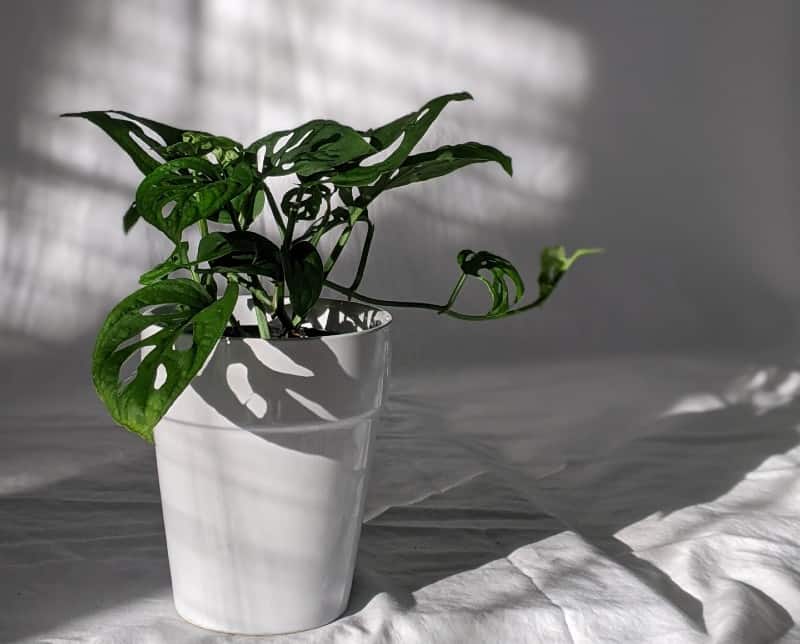
This is due to the white or yellow color of the leaves, which prevents them from absorbing as much light as other houseplants. A north or east-facing window is better for this intense light without the direct sun blazing down on the foliage.
Temperature & Humidity
Most Monstera plants thrive in a temperature range of 19 to 26 degrees Celsius. Don’t overlook their aversion to extreme temperatures, especially in the winter. The plant can be destroyed and even killed by cold and frost.
Therefore, before nature begins to reveal orangish hues in the fall, make sure to place the plant in a warm indoor location.
In an optimal humidity range of greater than 90%, these tropical plants appear lush and vigorous. Even though they can withstand moderate humidity levels, extra dry days might be detrimental to their health.
As a result, you must keep a sufficient level throughout the fall and winter. One of the more practical options is to place a pebble-water tray beneath the plant pot. You can also group the plants or use a humidifier in the vicinity.
Fertilizer
The variegated foliage, which has less chlorophyll, requires more fertilizers. As a result, fertilizer is more vital for this plant than for others. During the growing season, apply a regular houseplant fertilizer once or twice a month. Also, don’t fertilize it right after repotting it.
While still fragile, the roots are prone to fertilizer burn.
Propagation
Stem cuttings in soil are the most popular way to reproduce a Monstera. Place the cuts in a growing medium and keep them warm and dry until new growth appears.
Remember that new cuttings might take a long time to root, so be alert and place them in a wet, warm environment.
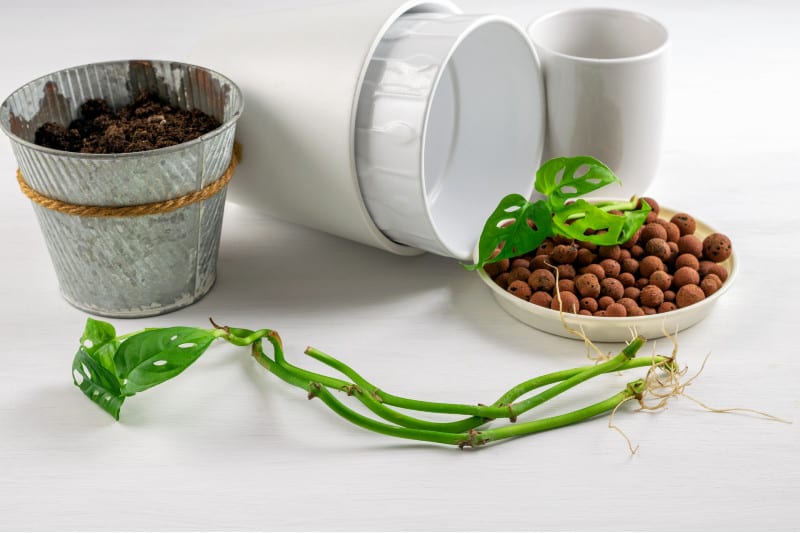
However, cutting the stem in the soil isn’t the only option. Stem cuttings in water can also be used to propagate the plant.
Growth Zone
Variegated Monstera Adansonii plant can reach a height of 13 feet. Its leaves can reach a length of three to four feet and its stem can reach up to two to three inches when fully matured. You will be able to see the holes in its leaves when the plant is older.
Since they have less chlorophyll than any regular indoor plants, they need bright light to thrive. Either indoor or outdoor setup, provide them with enough sunlight exposure and moisture to grow. Since this is a fast-growing plant that can reach its maturity in a year, make sure to prune them occasionally.
Potting
Use a large container with holes on the bottom for drainage. Until roughly three years, the Variegated Adansonii plant will do fine without frequent repotting. The presence of roots sprouting out of drainage holes indicates that it is time to repot. When the roots have too much room to stretch, this plant becomes stressed.
Keep in mind that a stressed plant is more vulnerable to diseases and pests.
Variegated Monstera Adansonii Varieties and Similar Plants
Monstera Deliciosa
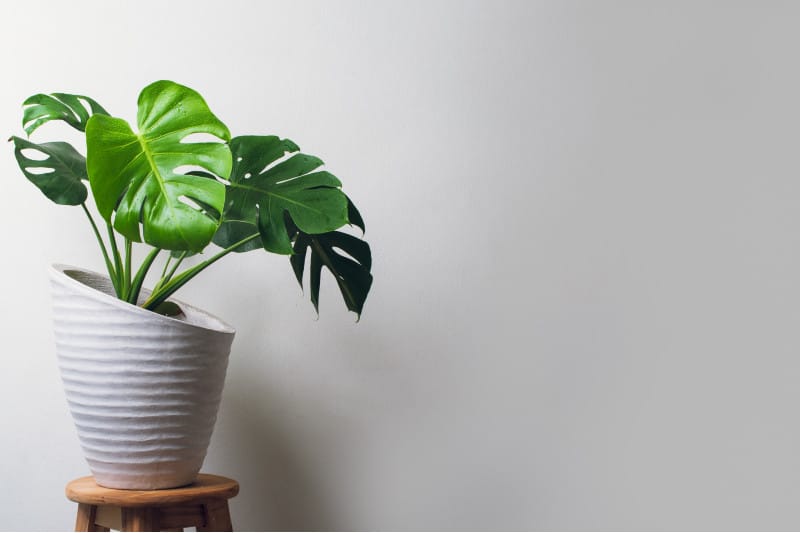
It features vast, beautiful holey leaves that are currently fashionable in nurseries and printed home decor. Because it yields Mexican breadfruit, this plant is nicknamed “deliciosa.”
Monstera Siltepecana
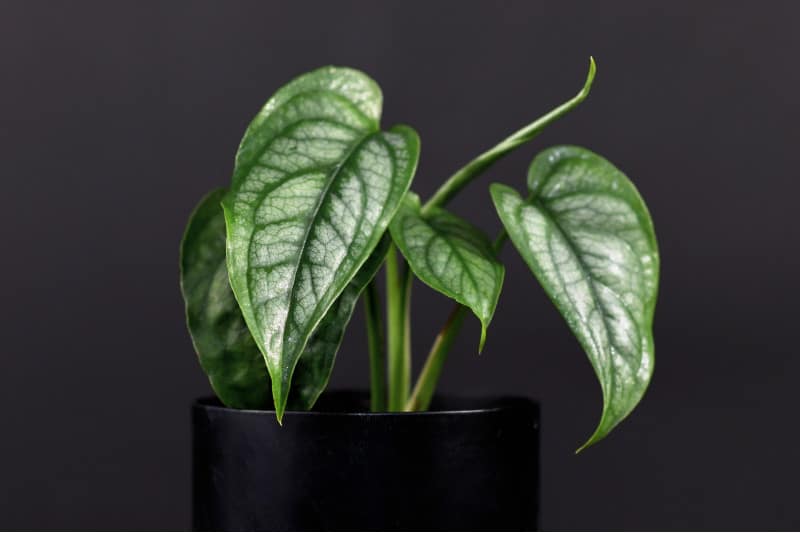
Large, teardrop-shaped leaves with tiny holes focused around the center vein characterize this attractive cultivar. They’re usually paler in color than other monsteras, with dark and light green tints. They’re tougher to obtain, but once you do, they’re stunning.
Rhaphidophora Tetrasperma or “Mini Monstera”
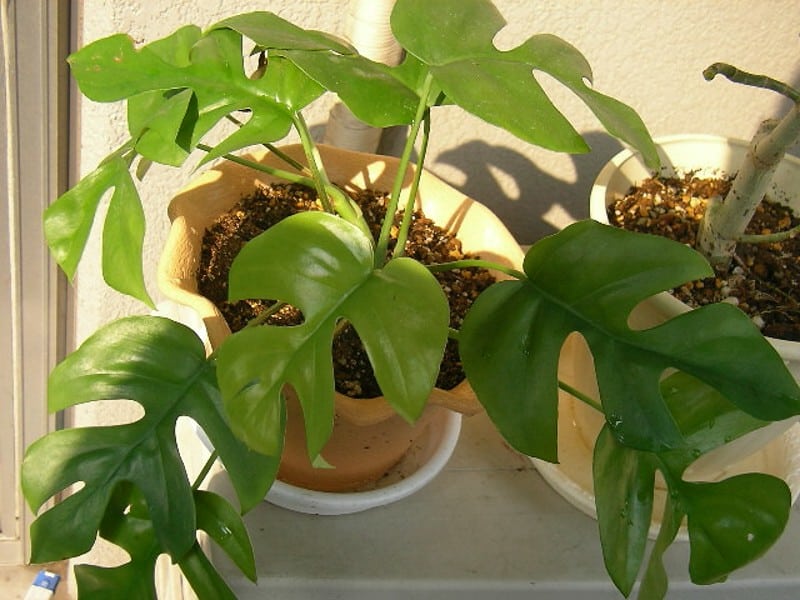
This plant resembles monstera in appearance, having the same characteristic holes in the leaves, except the enormous holes tend to stretch all the way to the leaf’s edge and appear more notched.
The deep green color is beautiful, and these monstera species are easier to care for than some of the more exotic monstera varieties.
Monstera Obliqua
The holes in these magnificent plants are still present, but the leaves are more holes than the leaf. These plants are exceedingly delicate, and you won’t find them in nurseries since the holes can swallow up to 90% of the paper-thin leaves.
Monstera Pinnatipartita
These varieties have huge, glossy leaves with slits rather than holes that run all the way to the leaf’s edge. The leaf stems are firm and durable, and their hue is beautiful emerald green.
These are a little more difficult to obtain, but you can typically find one or two on the internet.
Variegated Monstera Adansonii Diseases & Pests
Mealybugs, spider mites, scale, and whitefly may be a problem for the Swiss cheese plant, as they are for many other houseplants. These pests, fortunately, are rarely lethal and can be treated with a non-toxic insecticide or neem oil.
Additionally, look for symptoms of common diseases such as root rot, rust, powdery mildew, and a blight on your plant.
Frequently Asked Questions
Because variegated plants have a smaller surface area to photosynthesize with and make the sugars they need for growth and repair. They require more light and grow much slower than fully green plants. This is the reason why it is so highly sought after and expensive.
Animals are poisoned by Monstera plants. If you acquire one, make sure your cats and dogs can’t eat the leaves, which can cause irritation, mouth swelling, excessive drooling, vomiting, and difficulties swallowing if they consume them.
Your Monstera will extend to find a light source or something to climb onto if there isn’t enough light. The stems grow disproportionately and weaken as the plant expands out. This is known as etiolation, and it is the most common cause of legginess.
Since this plant is highly wanted due to its unique and rare characteristics, prices have skyrocketed too due to supply and demand. It’s best to seek trusted local nurseries or online stores that offer this stunning plant. Plantly is one of the few that holds high-quality plants such as the Variegated Adansonii and we will deliver it directly to your front door to avoid the hassle.
Whether you want to buy, sell or simply reach out to other plant enthusiasts, Plantly is the right place to be!


